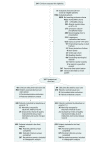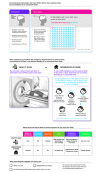Effect of the Head Computed Tomography Choice Decision Aid in Parents of Children With Minor Head Trauma: A Cluster Randomized Trial
- PMID: 30646167
- PMCID: PMC6324506
- DOI: 10.1001/jamanetworkopen.2018.2430
Effect of the Head Computed Tomography Choice Decision Aid in Parents of Children With Minor Head Trauma: A Cluster Randomized Trial
Abstract
Importance: The Pediatric Emergency Care Applied Research Network prediction rules for minor head trauma identify children at very low, intermediate, and high risk of clinically important traumatic brain injuries (ciTBIs) and recommend no computed tomography (CT) for those at very low risk. However, the prediction rules provide little guidance in the choice of home observation or CT in children at intermediate risk for ciTBI.
Objective: To compare a decision aid with usual care in parents of children at intermediate risk for ciTBI.
Design, settings, and participants: This cluster randomized trial was conducted in 7 geographically diverse US emergency departments (EDs) from April 1, 2014, to September 30, 2016. Eligible participants were emergency clinicians, children ages 2 to 18 years with minor head trauma at intermediate risk for ciTBI, and their parents.
Interventions: Clinicians were randomly assigned (1:1 ratio) to shared decision-making facilitated by the Head CT Choice decision aid or to usual care.
Main outcomes and measures: The primary outcome, selected by parent stakeholders, was knowledge of their child's risk for ciTBI and the available diagnostic options. Secondary outcomes included decisional conflict, parental involvement in decision-making, the ED CT rate, 7-day health care utilization, and missed ciTBI.
Results: A total of 172 clinicians caring for 971 children (493 decision aid; 478 usual care) with minor head trauma at intermediate risk for ciTBI were enrolled. The patient mean (SD) age was 6.7 (7.1) years, 575 (59%) were male, and 253 (26%) were of nonwhite race. Parents in the decision aid arm compared with the usual care arm had greater knowledge (mean [SD] questions correct: 6.2 [2.0] vs 5.3 [2.0]; mean difference, 0.9; 95% CI, 0.6-1.3), had less decisional conflict (mean [SD] decisional conflict score, 14.8 [15.5] vs 19.2 [16.6]; mean difference, -4.4; 95% CI, -7.3 to -2.4), and were more involved in CT decision-making (observing patient involvement [OPTION] scores: mean [SD], 25.0 [8.5] vs 13.3 [6.5]; mean difference, 11.7; 95% CI, 9.6-13.9). Although the ED CT rate did not significantly differ (decision aid, 22% vs usual care, 24%; odds ratio, 0.81; 95% CI, 0.51-1.27), the mean number of imaging tests was lower in the decision aid arm 7 days after injury. No child had a missed ciTBI.
Conclusions and relevance: Use of a decision aid in parents of children at intermediate risk of ciTBI increased parent knowledge, decreased decisional conflict, and increased involvement in decision-making. The intervention did not significantly reduce the ED CT rate but safely decreased health care utilization 7 days after injury.
Trial registration: ClinicalTrials.gov Identifier: NCT02063087.
Conflict of interest statement
Figures


Comment in
-
Shared Decision-Making Tools in Pediatric Acute Care: Enhancing Parent Knowledge and Trust.JAMA Netw Open. 2018 Sep 7;1(5):e182410. doi: 10.1001/jamanetworkopen.2018.2410. JAMA Netw Open. 2018. PMID: 30646159 No abstract available.
References
-
- Faul M, Xu L, Wald MM, Coronado VG. Traumatic Brain Injury in the United States: Emergency Department Visits, Hospitalizations and Deaths 2002-2006. Atlanta, GA: Centers for Disease Control and Prevention, National Center for Injury Prevention and Control; 2010. doi:10.15620/cdc.5571 - DOI
-
- Kuppermann N, Holmes JF, Dayan PS, et al. ; Pediatric Emergency Care Applied Research Network . Identification of children at very low risk of clinically-important brain injuries after head trauma: a prospective cohort study. Lancet. 2009;374(9696):1160-1170. doi:10.1016/S0140-6736(09)61558-0 - DOI - PubMed

